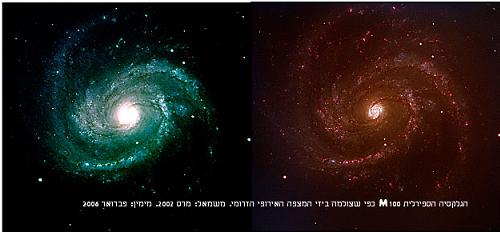Messier 100 is one of the most well-formed spiral galaxies showing a complex structure, with a bright core and two impressive arms. Now it is also easy to measure the exact distance to it
Avi Blizovsky

It is possible that this is a galaxy very similar to the Milky Way. Messier 100 is one of the most well-formed spiral galaxies showing a complex structure, with a bright core and two impressive arms, revealing a large number of young and massive stars as well as hot loops (HII regions). Two smaller arms start from the inside and extend towards the large helical arms.
The galaxy, which is 60 light years away from us and is slightly larger than the Milky Way, has a diameter of about 120 thousand light years. The galaxy was the target of the multispectral measuring instruments of the Very Large Telescope (VLT), at the request of astronomers Dietrich Budd and Ferdinando Petat, who, together with their colleagues Lipan Wang (Berkeley) and Craig Wheeler (University of Texas) observed the telescope and discovered a new supernova, SN 2006X.
SN 2006X was discovered in early February by Japanese amateur astronomer Shoji Suzuki and Italian astronomer Marco Migliardi. It was discovered on February 4 as the 24th supernova of the year. Its magnitude is 17, which means that it is a thousand times fainter than the galaxy itself. It soon became clear that this is yet another example of LA-type supernovae being observed before they reach their peak brightness. Indeed the supernova continued to brighten 25 times for about two weeks.
Because the supernova SN 2006X was so bright and because it is located inside the most studied galaxy M100, there was no doubt that a lot could be learned about the galaxy if more data were collected about the supernova and perhaps even about the system that exploded and in particular, to add sparks about this special type of supernova. This is especially important because these objects are used to measure the expansion of the universe because they all shine the same, so they can be used to accurately measure distances in the universe.
This is not the first supernova discovered in M100. In fact, it is one of the most prolific galaxies when it comes to supernovae. Since 1900, four other supernovae have been discovered: SN 1901B, SN 1914A, SN 1959E and SN 1979C. The latest observations made by the European Space Agency's Compton Space Observatory surprisingly showed that SN 1979 C is still as bright in the X-ray region as it was 25 years ago. However, in the visible light SN 1979C this supernova faded by a factor of 250. SN 1979C belongs to type 2 of the supernovae and it results from the explosion of a star that was 18 times heavier than the Sun.
For information on the Southern European Observatory website
